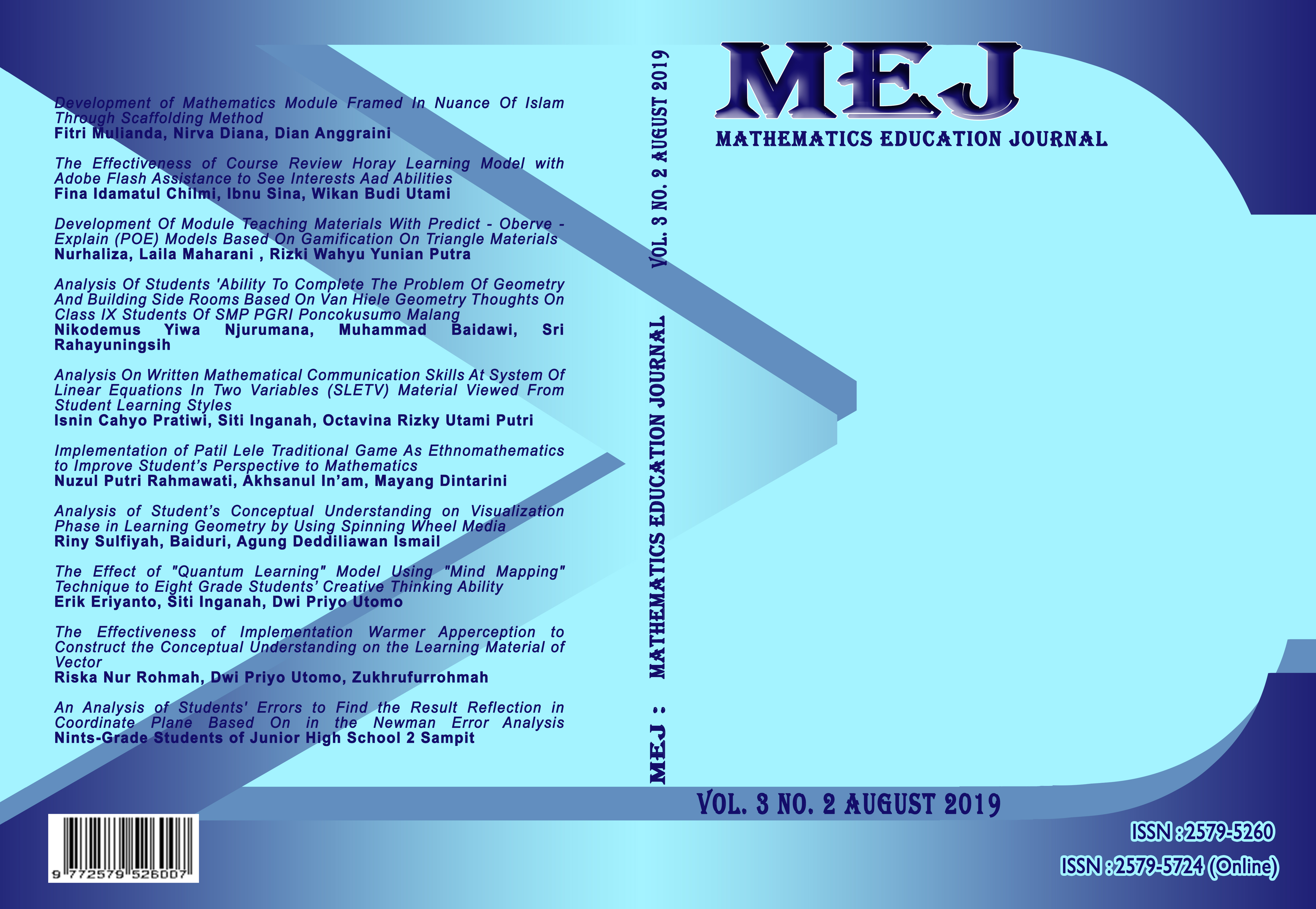Analysis On Written Mathematical Communication Skills At System Of Linear Equations In Two Variables (SLETV) Material Viewed From Student Learning Styles
DOI:
https://doi.org/10.22219/mej.v3i2.11069Keywords:
Student Learning Styles, Written Communication Skills, SLETV.Abstract
This research was to describe students’ mathematical communication skills based on their learning styles. This research was a descriptive research with qualitative approach. Data was obtained in three steps, namely written test on SLETV material, questionnaire on learning styles, and interviews. Research subject was eighth grade students. The procedure in this research began with the pre-field stage. At this stage, the research was designed, starting from observation and interviews with the teacher, as well as discussion with the supervisor. The second was the field stage, which was the stage for conducting research. The final stage was writing the report, which was the stage where researchers have conducted the research, processed and analyzed data that has been obtained from the research. Data collection techniques in this research were distributing questionnaire, giving test questions about SLETV, and conducting interviews to find out the students’ mathematical communication
skills more specifically. The instruments in this study were questionnaire on
learning styles, test questions about SLETV, and interview guide sheets. Data
analysis techniques in this research aimed to achieve data reduction by sorting out important answers from student results in the form of questionnaire, test, and interviews. Data presentation was in the form of narrative texts. Interviews were aligned with the test questions about SLETV. Finally, conclusions were formulated by describing each student’s written mathematical skill based on the 4 student learning styles. Based on the results, students with interpersonal learning style had the ability to learn better through friendship, students with self-expressive learning style had the ability to learn by paying more attention to the final results and tended to use unusual ways to find the best results, students with understanding learning style had the ability to see facts and remember large amounts of knowledge, ideas, theories, or concepts, while students with mastery learning style were able to write to the point and focus more on results.
Downloads
References
Afnaria. (2012). Kemampuan Komunikasi Matematis dan Pembelajaran Interaktif. Jurnal Pendidikan Matematika Vol.1 No. 1 Part 2 : 77-8
Auliana, Novi. (2017). Analisis Kemampuan Komunikasi Matematis Siswa Pada Materi Statistika Ditinjau Dari Gaya Belajar Visual, Auditorial, Kinestetik (Vak). Jurusan Pendidikan Matematika. FKIP. Universitas Nusantara Persatuan Republik Guru Indonesia.
Ferrara, Jean. (2015). The Effect Of Learning Style Strategies On Benchmark Eight Grade middle School Mathematics Achievment. Walden University
Gordah, E,K. Nurmaningsih. 2015. Analisis Kemampuan Komunikasi Matematis Mahasiswa pada Materi Kuliah Geometri Analitik di Program Studi Pendidikan Matematika IKIP PGRI Pontianak. Jurnal Pendidikan Informatika dan Sains, Vol. 4 (2)
Keliat, Ramlan. (2014). Perbandingan Gaya Belajar Interpersonal dengan Gaya Belajar Penguasaan Terhadap Hasil Belajar Matematika Mahasiswa Calon Guru. Jurnal Matematika Vol 2 No 1 Hal 221-226
Kosko, K. J,Wilkins. 2012. Mathematical Communication and Its Relation to the Frequency of Manipulative Use. International Electronic Journal of Mathematics Education, Vol.2, No.5, hal.1-12. Tersedia di http://www.mathedujournal.com/dosyalar/IJEM_v5n2_2.pdf
[diakses 26 desember 2015]
Lestari, Karunia Eka dan Mokhammad Ridwan Yudhanegara. 2014. Penelitian Pendidikan Matematika. Bandung: PT Refika Aditama.
Mas’udah, A. Nur. (2016). Analisis Kemampuan Komunikasi Matematis Ditinjau Dari Gaya Belajar Pada Model Pembelajaran Knisley. Jurusan Pendidikan Matematika. FMIPA.
Universitas Negri Semarang
Mulyono. 2012. Strategi Pembelajaran, (Malang: UIN-Maliki Press), hlm. 226-228
Silver, H. F.dkk. 2013. Pengajaran Matematika, Kurikulum Inti Bersama, Seri Pengajaran Tematik Integratif. Jakarta: PT. Indeks
Sukadi. 2008. Progressive learning: Learning by spirit. Bandung: MQS
Wardhana, I. R., & Lutfianto, M. (2018). Analisis Kemampuan Komunikasi Matematis Ditinjau Dari Kemampuan Komunikasi Matematika Siswa, Surabaya, Jurnal Pendidikan Matematika (Vol. 6 Nomor 2 Tahun 2018).
Zainul. (2016). Analisis Kemampuan Komunikasi Matematika Dalam Menyelesaikan Masalah Pada Pokok Bahasan Sistem Persamaan Linier Dua Variabel Siswa Kelas VIII-C
SMP Nuris Jember. Jurusan Pendidikan Matematika. FMIPA. Universitas Negri Bandung.
Downloads
Published
Issue
Section
License
Authors who publish with MEJ (Mathematics Education Journal) agree to the following terms:
For all articles published in MEJ, copyright is retained by the authors. Authors give permission to the publisher to announce the work with conditions. When the manuscript is accepted for publication, the authors agree to automatic transfer of the publishing right to the publisher.
Authors retain copyright and grant the journal right of first publication with the work simultaneously licensed under a Creative Commons Attribution-ShareAlike 4.0 International License that allows others to share the work with an acknowledgment of the work's authorship and initial publication in this journal.
Authors are able to enter into separate, additional contractual arrangements for the non-exclusive distribution of the journal's published version of the work (e.g., post it to an institutional repository or publish it in a book), with an acknowledgment of its initial publication in this journal.
Authors are permitted and encouraged to post their work online (e.g., in institutional repositories or on their website) prior to and during the submission process, as it can lead to productive exchanges, as well as earlier and greater citation of published work (See The Effect of Open Access).

This work is licensed under a Creative Commons Attribution-ShareAlike 4.0 International License.










